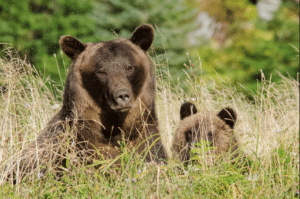What Smokey the Bear Forgot about Wildfires
By Ole Hendrickson, President of the Board of Directors, Sierra Club Canada

Photo by / par Barry Stemshorn
The U.S. Ad Council says “the Smokey Bear Wildfire Prevention campaign is the longest-running public service advertising campaign in U.S. history, educating generations of Americans about their role in preventing wildfires.”
For more than half a century, Smokey told us “Only YOU can prevent forest fires.”
Smokey got the message out effectively: carelessness destroys forests. He taught us to look after our campfires, which is a good thing.
Too bad he didn’t give us the whole picture.
Fires happen no matter how careful people are. Lightning strikes burn far more acres of forest than human carelessness. We simply can’t prevent all fires.
Nor would we want to.
Fire is one of the great ecological forces shaping life on the planet. Fire rejuvenates prairies and forests. In the absence of periodic fires, trees and shrubs encroach on mountain meadows. Habitat for elk and antelope disappears.
Lack of fire in the B.C. interior has created a monotonous landscape of mature lodgepole pine stands, with high risks of catastrophic fires and insect outbreaks. The devastating mountain pine beetle outbreak was worsened by global warming, but past fire control practices created prime habitat for the beetle.
When housing developments spread into fire-prone forests, fire suppression becomes an issue of protecting life and property. But this is just like building homes on a hurricane-prone coast: the odds are that the big one will come, sooner or later.
Fire needn’t be a disaster. Over-zealous efforts to suppress fire have created stands with too many trees, prone to drought and disease, many with dying branches and stems. This is a prescription for catastrophic fires.
Maybe Smokey spent too much time among humans. Maybe he’d stopped eating blueberries and other foods that flourish in post-fire environments. He should have gone back to his roots and explained fire from Nature’s perspective.
Fire created the great white and red pine forests of the Great Lakes and Ottawa Valley regions. These were not great conflagrations, but gentler surface fires that burned off surface organic soil horizons, cleared away fir seedlings, and created space for the next generation of pine seedlings.
Mature pines, with thick bark and no lower branches that allow “laddering” of fire up the stem, easily survived these surface fires. Over time, pines became more and more dominant in the landscape. Our efforts to control fire have reversed this process. Denser forests of maple, birch, fir, and poplar occupy lands where great pines once stood.
Further north in the boreal region, crown fires transform immense tracts of spruces and pines into smoking, charred skeletons. Surface soil is reduced to ash. But here too, fire brings new life. Cones are opened by the heat, seeds are shed, and phoenix-like, spruce and pine seedlings rise from the ashes.
We can change the way change happens, but we cannot stop change itself.
Earlier inhabitants of Turtle Island understood this much better than we do. For them, fire was a tool for deliberately shaping landscapes.
Scientists were ridiculed when they first raised the possibility that Indigenous peoples made extensive use of fire. Today, scientists are learning aboriginal burning techniques and applying them as part of the management toolkit.
Australia is one of the last places where Indigenous peoples have continued their traditional burning practices in uninterrupted fashion. They set fires almost casually, at times of the year when no one would dare burn an area that had not been burned regularly.
Left to itself, Nature often creates ecosystems where fires burn too fiercely for human safety.
Use of regular, prescribed fire can restrain Nature’s propensity to allow dangerous wildfires. It’s a sign of just how disconnected Smokey had gotten from his roots that he never explained this to us.
